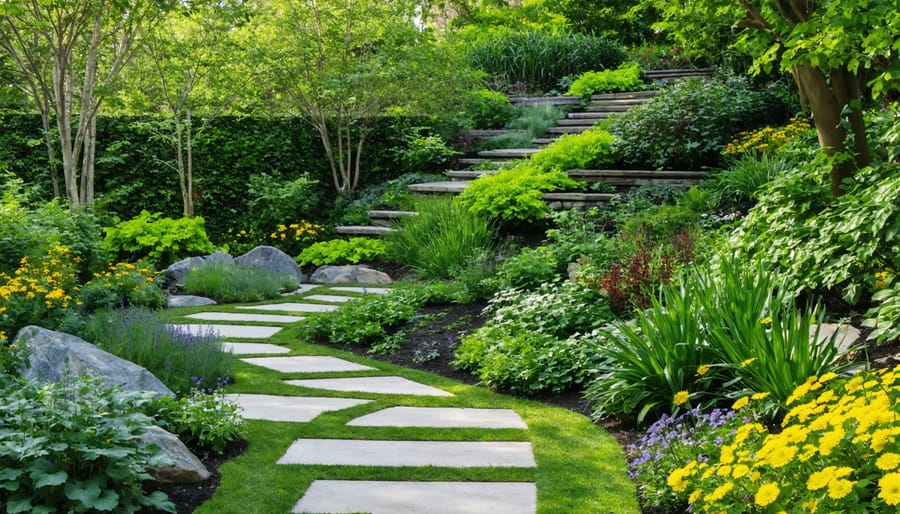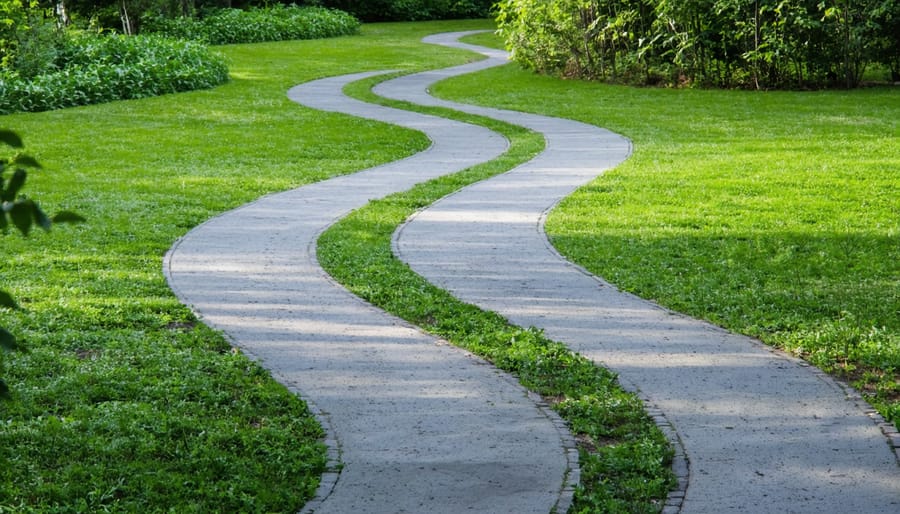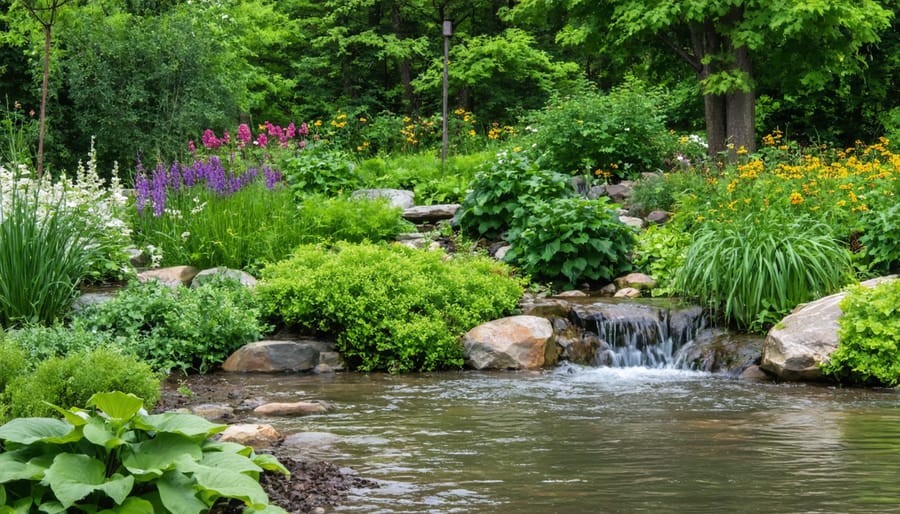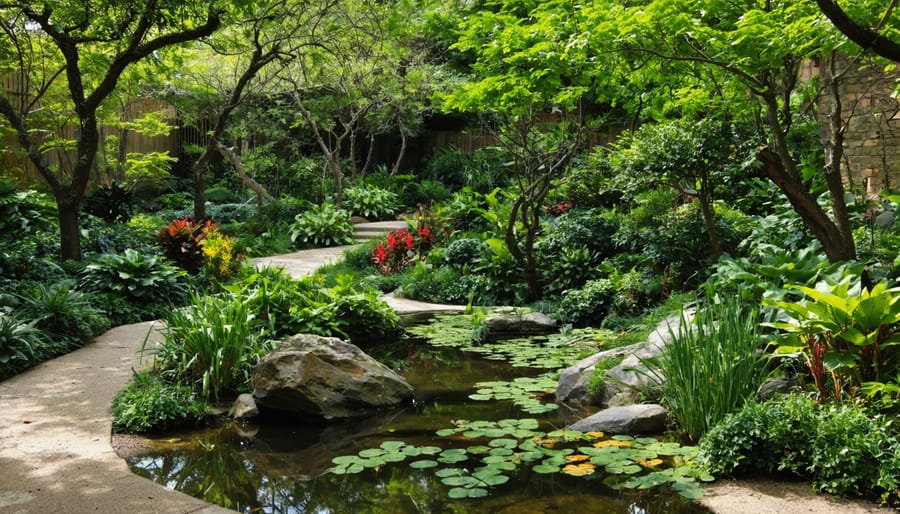Transform your outdoor space into a self-sustaining ecosystem by applying landscape ecology principles that mirror nature’s own design patterns. Connect fragmented garden areas with native plant corridors to create wildlife highways that support local biodiversity. Position taller plants and trees strategically to form natural windbreaks and microclimates, protecting delicate species while reducing water evaporation. Layer vegetation vertically – from ground covers to canopy trees – maximizing space utilization while creating diverse habitats for beneficial insects and birds. These ecological design principles work together to build resilient landscapes that thrive with minimal intervention, turning your garden into a living, breathing extension of the natural world.
Nature’s Building Blocks: Core Elements of Landscape Ecology
Habitat Patches: Creating Living Spaces
Creating habitat patches in your garden is like building a series of interconnected nature hotels, each catering to different wildlife guests. Start by identifying distinct areas in your garden that can serve as mini-ecosystems. A sunny corner might become a wildflower meadow, while a shaded area could transform into a woodland garden with native ferns and shade-loving perennials.
Layer your plantings vertically to maximize habitat potential. Include ground covers, mid-height perennials, shrubs, and if space allows, trees. This creates multiple levels of living space that different creatures can call home. For instance, dense shrubs provide nesting sites for birds, while fallen leaves underneath create shelter for beneficial insects and small mammals.
Consider creating specialized habitat features within these patches. A small pond becomes a haven for amphibians and dragonflies, while a rock garden offers basking spots for lizards and hibernation sites for insects. Dead wood piles, often overlooked in traditional gardens, make excellent homes for beetles and other decomposers.
Connect these habitat patches with wildlife corridors – strips of native plants that allow animals to move safely between areas. These can be as simple as a flowering border along a fence or a hedge connecting different parts of your garden. Even small gardens can incorporate multiple habitat patches by thinking vertically and using features like green walls or climbing plants.
Remember to include food sources in your habitat patches by choosing plants that provide berries, seeds, or nectar throughout different seasons. This ensures your garden supports wildlife year-round.

Corridors and Connectivity
In nature, plants and animals need to move freely between different habitats to thrive. Just as we use sidewalks and roads to get around our neighborhoods, wildlife requires similar pathways through our landscapes. Creating wildlife corridors in your garden can be as simple as connecting different planted areas with strips of native vegetation.
Think of these corridors as nature’s highways, allowing birds to hop from tree to tree, butterflies to flutter between flower patches, and small mammals to safely traverse your property. Even in urban settings, you can establish these vital connections using hedgerows, flower borders, or lines of shrubs that link larger habitat areas.
The key to successful corridors is continuous plant coverage. Imagine stepping stones across a pond – if they’re too far apart, you can’t cross. Similarly, wildlife needs closely spaced vegetation to feel secure while moving through your landscape. Try to avoid gaps larger than a few feet between planted areas.
When planning these connections, use a variety of plants at different heights. Ground covers provide safety for small creatures, while taller shrubs and trees offer shelter for birds and climbing species. Remember that these corridors don’t have to be straight lines – natural, meandering paths often work better and look more appealing in your garden design.

Working with Your Garden’s Natural Flow
Reading Your Land’s Story
Every garden tells a story, and learning to read your land’s natural patterns is like unlocking a fascinating book written by nature itself. Start by observing your garden throughout different seasons and weather conditions. Notice where water naturally flows during rain, which areas stay soggy, and where the ground dries quickly. These patterns reveal important information about your soil’s drainage and microclimate zones.
Pay attention to existing plant communities – they’re excellent indicators of your site’s conditions. Thriving native plants show which species are well-suited to your local environment. Look for signs of wildlife activity too, as these reveal important ecological connections in your garden ecosystem.
Sun and shade patterns play a crucial role in your land’s story. Track how sunlight moves across your property throughout the day and across seasons. These observations will help you identify prime spots for different types of plants and garden features.
Don’t forget to investigate your soil. Its color, texture, and the organisms living within it tell you about its health and composition. Take note of any existing slopes, rocks, or unique landscape features – these natural elements can become valuable assets in your garden design.
Remember, successful ecological gardening starts with understanding and working with these existing patterns rather than fighting against them. Your land’s story provides the foundation for creating a thriving, sustainable garden that feels right at home in its environment.
Plant Communities, Not Just Plants
Just as in nature, plants thrive best when growing alongside compatible companions. Creating plant communities in your garden means thinking beyond individual specimens and focusing on how different plants work together to create a harmonious, self-sustaining ecosystem.
Think of your garden as a neighborhood where each plant plays a unique role. Some plants, like deep-rooted natives, act as soil anchors, while others, such as nitrogen-fixing legumes, improve soil fertility. Ground covers protect soil and retain moisture, while taller plants provide shade and wind protection for more delicate species.
A well-planned plant community typically includes several layers: tall trees or shrubs for structure, mid-height flowering plants for color and pollinator attraction, low-growing ground covers, and root crops or bulbs below ground. This vertical layering mimics natural ecosystems and maximizes space usage while reducing maintenance needs.
When selecting plants for your community, consider their growth patterns, water requirements, and seasonal changes. For example, spring bulbs can share space with summer-blooming perennials, ensuring continuous garden interest. Native plant combinations often work best as they’ve evolved together and naturally support each other’s growth.
Remember, successful plant communities develop over time. Start with a core group of compatible plants and observe how they interact. You’ll soon notice your garden becoming more resilient, requiring less intervention, and supporting more wildlife.
Water-Wise Design Strategies
In nature, water flows and collects in predictable patterns, and smart gardeners can work with these natural tendencies rather than against them. Implementing water-wise garden design starts with observing how water naturally moves through your landscape during rainfall.
Begin by mapping high and low points in your garden, noting where water tends to pool or run off quickly. Create gentle slopes and swales that direct water flow to where it’s needed most, like garden beds or rain gardens. These shallow depressions can slow water movement, allowing it to seep naturally into the soil rather than rushing away as runoff.
Consider incorporating permeable surfaces like gravel paths or stepping stones instead of solid concrete. These allow water to filter through gradually, replenishing groundwater supplies. Strategic placement of plants also plays a crucial role – deep-rooted native species can help stabilize soil and improve water retention.
Rain gardens are particularly effective water management features, positioned in natural low points to collect runoff. Plant these areas with moisture-loving species that can handle both wet and dry conditions. Don’t forget about rainwater harvesting – installing rain barrels or cisterns can capture valuable water for use during dry spells.
Remember, successful water management isn’t about fighting nature – it’s about working with it to create a more resilient and sustainable landscape.

Bringing it All Together: Your Eco-Design Action Plan
Starting Small: First Steps to Success
Starting your journey in landscape ecology doesn’t require a complete garden overhaul. In fact, the most successful transformations often begin with small, manageable projects that gradually expand over time. Think of it as building a natural jigsaw puzzle, one piece at a time.
A great first step is creating a simple pollinator patch using native flowers. Even a 3×3 foot area can become a vibrant ecosystem supporting local bees and butterflies. Choose three or four native plant species that bloom at different times, and you’ll be amazed at the wildlife it attracts.
Water conservation is another excellent starting point. Installing a rain barrel or creating a small rain garden can make a significant impact. These projects typically take just a weekend to complete and immediately start benefiting your landscape.
Consider transforming a small section of your lawn into a native plant zone. Start with a 100-square-foot area (about the size of a parking space) and observe how it changes throughout the seasons. This gives you valuable hands-on experience with native plant care while creating a maintenance-free garden space.
Remember, successful landscape ecology is about observation and adaptation. Take notes on what works in your space, which plants thrive, and what wildlife visits. These observations will guide your future projects and help you develop a deeper understanding of your garden’s ecosystem.
Maintaining the Balance
Successful ecological gardens require dedication to maintaining ecological balance through thoughtful, long-term management strategies. Think of your garden as a living symphony where every element plays its part. Regular monitoring helps you spot potential issues before they become problems, while seasonal maintenance keeps your garden healthy and vibrant.
Start by establishing a yearly maintenance calendar that aligns with natural cycles. Spring calls for gentle pruning and soil amendment, summer focuses on water management and pest monitoring, fall involves strategic plant division and leaf management, and winter allows for structural improvements and planning.
Consider implementing a rotating plant schedule to prevent soil depletion and reduce pest problems. Mix deep-rooted plants with shallow-rooted ones to maximize soil health and minimize competition. Remember to leave some areas undisturbed as wildlife habitats – those fallen leaves and hollow stems provide essential shelter for beneficial insects and small creatures.
Water management is crucial for long-term success. Install rain gardens or swales to capture and direct water flow, and use mulch to retain moisture and suppress weeds naturally. Regular soil testing helps you adjust your management practices, ensuring your garden remains healthy without relying on chemical interventions.
Don’t forget to document your observations and adjustments. A simple garden journal can become an invaluable tool for understanding your landscape’s unique patterns and needs over time.
Common Challenges and Solutions
Creating an ecologically sound landscape can present several common challenges, but don’t worry – there’s always a solution! One frequent issue gardeners face is managing invasive species that can quickly overtake native plants. The best approach is regular monitoring and early intervention, combined with choosing native alternatives that naturally compete well with invasive plants.
Water management often proves tricky, especially in areas prone to drought or flooding. Consider installing rain gardens or swales to handle excess water, and group plants with similar water needs together. This practice, known as hydrozoning, helps maintain efficient water use while keeping your plants happy.
Soil health can be another stumbling block. Many gardeners inherit poor or compacted soil in their landscapes. The solution lies in gradually building soil health through composting, mulching, and allowing fallen leaves to decompose naturally. Remember, healthy soil leads to resilient plants that require less maintenance.
Wildlife conflicts sometimes arise when creating wildlife-friendly spaces. If deer are munching on your favorite plants, try incorporating naturally deer-resistant species or using physical barriers that blend with your landscape design. For pest issues, focus on attracting beneficial insects by planting diverse flowering species.
Balancing aesthetics with ecology might seem daunting at first. Start small by incorporating native plants in traditional garden designs, creating “orderly chaos” that pleases both human sensibilities and local wildlife. With time and patience, these challenges become opportunities to create more resilient and beautiful landscapes.
As we’ve explored throughout this article, landscape ecology principles offer a powerful framework for creating gardens that are both beautiful and environmentally sustainable. By embracing these concepts, you’re not just designing a garden; you’re creating a living ecosystem that supports local wildlife, conserves resources, and brings joy to your outdoor space.
Remember that implementing these principles doesn’t require a complete garden overhaul. Start small by incorporating native plants, creating wildlife corridors, or establishing water-efficient zones. Each step you take contributes to a more resilient and sustainable landscape.
Consider beginning with a simple project, like replacing a portion of your lawn with diverse native plantings or adding a small water feature that supports local wildlife. As you become more comfortable with these concepts, you can gradually expand your ecological design elements throughout your garden.
The rewards of applying landscape ecology principles extend far beyond your property lines. You’ll notice increased biodiversity, reduced maintenance needs, and a deeper connection to the natural world around you. Plus, your garden will serve as an inspiration and educational tool for neighbors and visitors.
Take action today by choosing one principle to implement this season. Whether it’s improving habitat connectivity, establishing plant communities, or managing water flow more effectively, your efforts will contribute to a healthier, more sustainable environment for generations to come.




